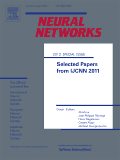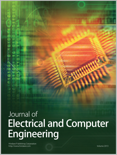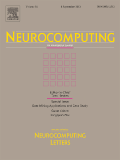
NEURAL NETWORKS
Scope & Guideline
Exploring the Frontiers of AI and Cognitive Neuroscience
Introduction
Aims and Scopes
- Neural Network Architectures and Innovations:
Research on new architectures for neural networks, including convolutional, recurrent, and hybrid models that enhance performance in various applications. - Learning Algorithms and Optimization Techniques:
Development and analysis of algorithms for training neural networks, including optimization methods, reinforcement learning strategies, and adaptive learning techniques. - Applications of Neural Networks:
Exploration of practical applications of neural networks in fields such as computer vision, natural language processing, robotics, and bioinformatics. - Theoretical Foundations and Interpretability:
Studies that aim to understand the theoretical underpinnings of neural networks, including their expressiveness, generalization capabilities, and interpretability. - Adversarial Learning and Robustness:
Research focusing on the resilience of neural networks against adversarial attacks and the development of techniques to enhance their robustness.
Trending and Emerging
- Neural Architecture Search (NAS):
An increasing focus on automated methods for discovering optimal neural network architectures, indicating a shift towards optimization and efficiency in model design. - Explainable AI and Interpretability:
A growing interest in making neural networks more interpretable, focusing on understanding decision-making processes, which is crucial for trust in AI systems. - Federated Learning and Privacy Preservation:
Emerging research in federated learning highlights the need to perform machine learning on decentralized data while maintaining privacy, reflecting concerns about data security. - Integration of Neural Networks with Other AI Techniques:
An increasing trend towards combining neural networks with reinforcement learning, evolutionary algorithms, and other AI methodologies to tackle complex problems. - Physics-Informed Neural Networks:
A rise in research that integrates physical laws into the training of neural networks, showcasing their application in modeling complex systems.
Declining or Waning
- Traditional Supervised Learning Techniques:
As attention shifts to more complex learning paradigms such as semi-supervised, unsupervised, and reinforcement learning, traditional supervised learning techniques are being explored less frequently. - Basic Neural Network Models:
Research focusing on simpler neural network models, such as basic feedforward architectures, is becoming less common in favor of more advanced architectures and hybrid approaches. - Static Neural Network Applications:
The interest in applications of static neural networks for traditional tasks is waning, as dynamic, adaptive, and context-aware models gain traction. - Manual Feature Engineering:
The trend towards automated feature learning through deep learning has reduced the focus on manual feature engineering in neural network applications.
Similar Journals

Journal of Electrical and Computer Engineering
Fostering Collaboration in a Dynamic Engineering LandscapeJournal of Electrical and Computer Engineering is a premier open-access journal published by HINDAWI LTD, dedicated to advancing the fields of electrical and computer engineering. With an ISSN of 2090-0147 and an E-ISSN of 2090-0155, this journal has been providing a platform for cutting-edge research since its inception in 2007. Based in the United States, it operates from its address at ADAM HOUSE, 3RD FLR, 1 FITZROY SQ, LONDON W1T 5HF, ENGLAND. The journal has established itself with a healthy impact factor, classified in the 2023 Q2 quartile for both Computer Science (Miscellaneous) and Electrical and Electronic Engineering, demonstrating its growing influence in the academic community. Additionally, its ranking positions it within the 67th percentile in General Computer Science and the 61st percentile in Electrical and Electronic Engineering on Scopus, indicating its significant contribution to these fields. Covering an extensive scope from 2010 to 2024, the journal seeks to publish innovative research articles, reviews, and case studies that explore new techniques and applications in electrical and computer engineering, benefiting a wide audience of researchers, professionals, and students focused on these rapidly-evolving areas.

Robotic Intelligence and Automation
Transforming Ideas into Intelligent Solutions.Robotic Intelligence and Automation is a pioneering academic journal dedicated to the exploration and advancement of knowledge within the realms of robotics, artificial intelligence, and automation technologies. Published by EMERALD GROUP PUBLISHING LTD in the United Kingdom, this journal serves as a critical platform for researchers, professionals, and students who strive to understand and innovate in these rapidly evolving fields. With an impressive visibility across multiple disciplines, it has achieved a respectable Q2 ranking in Computer Science Applications, Control and Systems Engineering, Electrical and Electronic Engineering, and Industrial and Manufacturing Engineering, while also being recognized in Q3 for Artificial Intelligence and Human-Computer Interaction. The journal boasts a comprehensive Open Access model, allowing broad dissemination of research findings, which is vital for fostering collaboration and learning within the scientific community. Researchers can look forward to contributing to a publication that not only addresses current challenges but also seeks to shape the future of intelligent automation and robotics.

NEUROCOMPUTING
Transforming Insights into Intelligent SolutionsNEUROCOMPUTING is a premier academic journal published by ELSEVIER, specializing in the interdisciplinary fields of Artificial Intelligence, Cognitive Neuroscience, and Computer Science Applications. With an impressive impact factor and a Q1 ranking in its relevant categories for 2023, NEUROCOMPUTING is recognized as a leader in fostering innovative research and providing a platform for ground-breaking studies. The journal’s scope covers the convergence of neural computation and artificial intelligence, making it essential reading for researchers and professionals seeking to explore the latest advancements and applications in these dynamic fields. For those interested in the cutting-edge intersection of neuroscience and computational techniques, NEUROCOMPUTING offers a wealth of knowledge that significantly contributes to both theoretical and practical advancements. The journal is dedicated to publishing high-quality, peer-reviewed articles and is an invaluable resource for students and established scholars alike, looking to stay at the forefront of research trends.

Neural Network World
Connecting Minds: Where Technology Meets NeuroscienceNeural Network World, published by the Academy of Sciences of the Czech Republic, Institute of Computer Science, is a preeminent journal dedicated to the fields of artificial intelligence, hardware and architecture, software engineering, and neuroscience. Since its inception in 1994, this journal has provided a platform for the dissemination of pioneering research and technical advancements in neural networks and their applications. Operating from the heart of Prague, this publication holds a Q4 quartile ranking across key categories, highlighting the growing interest and relevance in its multidisciplinary focus. Although it does not currently offer open access, its commitment to scholarly rigor ensures that readers engage with high-quality content, making it a valuable resource for researchers, professionals, and students alike. As the field evolves, Neural Network World serves as an essential forum for innovative ideas and critical discussions, reinforcing its significance in driving forward the future of technology and neuroscience.

NEURAL COMPUTING & APPLICATIONS
Illuminating the Future of AI and Software DevelopmentNEURAL COMPUTING & APPLICATIONS is a premier journal dedicated to the burgeoning fields of Artificial Intelligence and Software Engineering, published by Springer London Ltd. Established in 1993, the journal serves as a pivotal platform for disseminating cutting-edge research and innovative applications in neural computing, covering a broad range of topics from algorithm development to real-world applications. With its impressive categorization in the 2023 Journal Quartiles—ranging Q2 in Artificial Intelligence and Q1 in Software—it stands out in its discipline, ranking 42nd out of 407 in Computer Science Software and 50th out of 350 in Computer Science Artificial Intelligence, reflecting its significant impact in the academic community. Although not an open access journal, it provides vital access to significant findings and methodologies that drive advancements in technology. Researchers, professionals, and students looking to stay abreast of the most relevant and impactful developments in these fields will find NEURAL COMPUTING & APPLICATIONS an indispensable resource.

NEURAL PROCESSING LETTERS
Connecting Disciplines for Tomorrow's Innovations.NEURAL PROCESSING LETTERS, published by Springer, is a prestigious journal dedicated to the interdisciplinary fields of Artificial Intelligence, Computer Networks and Communications, Software Engineering, and Neuroscience. Established in 1994, the journal has built a solid reputation over the past decades, showcasing innovative research and developments that significantly contribute to the advancement of these dynamic areas. With a 2023 Scopus quartile ranking of Q2 in Artificial Intelligence and Computer Networks and Communications, and a Q3 ranking in Neuroscience, this journal occupies an important niche for professionals and researchers alike. The journal’s impact is further evidenced by its competitive Scopus ranks, positioning it within the top 60th percentile across its categories. Researchers looking for a platform to disseminate their findings in the intersection of technology and neuroscience will find NEURAL PROCESSING LETTERS an invaluable resource. For additional engagement and visibility, the journal supports various access options; however, it's important to note that it does not currently operate under an open access model. For submissions or queries, the journal can be reached at its headquarters in Dordrecht, Netherlands.

International Journal of Fuzzy Logic and Intelligent Systems
Fostering Excellence in Fuzzy Logic and AI ResearchInternational Journal of Fuzzy Logic and Intelligent Systems, ISSN: 1598-2645, is a prestigious journal published by the Korean Institute of Intelligent Systems, dedicated to advancing the fields of Artificial Intelligence, Computational Theory and Mathematics, Computer Science Applications, Logic, and Signal Processing. Established to foster interdisciplinary research, this journal has quickly established its reputation, reaching a respectable Q3 quartile ranking across multiple categories in 2023. It serves as a vital resource for researchers, professionals, and students, offering insights into cutting-edge methodologies and innovative applications of fuzzy logic and intelligent systems. With a focus on disseminating high-quality research, the journal attracts contributions that drive the evolution of intelligent technologies and their practical implications. Published from South Korea, the journal is positioned to impact the global community, facilitating a deeper understanding of intelligent systems in various domains.

NETWORK-COMPUTATION IN NEURAL SYSTEMS
Fostering Collaboration in Network and Neural ComputationNETWORK-COMPUTATION IN NEURAL SYSTEMS is a distinguished journal published by Taylor & Francis Inc, focusing on the innovative intersection of network theory and neural computation. Since its inception in 1990, this journal has provided a vital platform for researchers and professionals in the field of neuroscience, exploring the dynamics of neural networks and computational models. With its current Q3 category ranking in Neuroscience (miscellaneous) and a robust position in Scopus, the journal plays a critical role in advancing knowledge and discussion within this interdisciplinary area. The journal addresses a wide range of topics related to the computational aspects of neural systems, fostering collaboration and providing valuable insights amongst scholars. Although it is not an open-access publication, its well-curated content remains accessible through institutional subscriptions, ensuring that significant research reaches the hands of those who need it. As it continues to evolve through 2024 and beyond, NETWORK-COMPUTATION IN NEURAL SYSTEMS stands as a key resource for anyone deeply engaged in understanding the complexities and intricacies of neural computations.

SOFT COMPUTING
Pioneering Innovations in Computational IntelligenceSOFT COMPUTING is a premier international journal published by Springer, focusing on the interdisciplinary field of soft computing, which includes areas such as fuzzy logic, neural networks, genetic algorithms, and their applications. With an ISSN of 1432-7643 and E-ISSN 1433-7479, the journal is based in Germany and contributes significantly to the advancement of knowledge in its fields, boasting an impressive Scopus ranking that places it in the top echelons of Geometry and Topology, Theoretical Computer Science, and Software categories. In the 2023 category quartiles, it has achieved Q2 rankings in multiple disciplines, reflecting its high-quality research contributions. Though not Open Access, the journal's rigor and relevance to contemporary issues make it a favored resource for researchers, professionals, and students alike. From its inception in 2000 and spanning across the years until 2024, SOFT COMPUTING continues to serve as a robust platform for innovative research and theoretical advancements, making it an essential read for anyone engaged in the rapidly evolving landscape of computational intelligence.

Quantum Machine Intelligence
Advancing the frontier of quantum algorithms and AI.Quantum Machine Intelligence is a leading academic journal published by Springer Nature, focusing on the rapidly evolving intersection of quantum computing and artificial intelligence. With an impressive impact factor reflected in its prestigious ranking in various categories—Q1 in Applied Mathematics, Computational Theory and Mathematics, and Theoretical Computer Science, alongside Q2 in Artificial Intelligence and Software—this journal serves as a vital platform for disseminating innovative research from 2019 to 2024. Researchers, professionals, and students are encouraged to engage with the journal’s content, which features high-quality peer-reviewed articles that explore theoretical foundations and practical applications of quantum technologies in machine intelligence. Although the journal operates under traditional subscription models, it is committed to advancing open academic discourse and accessibility in the digital age. With Scopus rankings that place it among the top echelons of its fields, the journal is an essential resource for anyone interested in the transformative potential of quantum algorithms and AI.